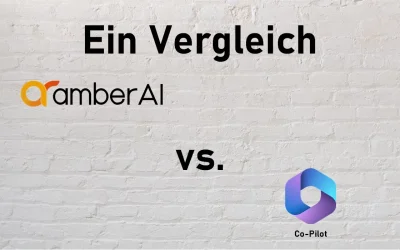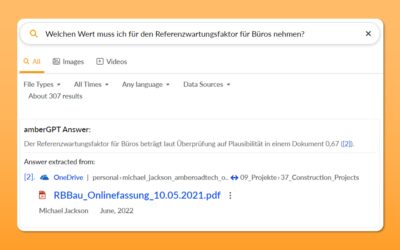What are the use cases with generative AI in companies? Any software is only as good as the use case that needs to be solved. More and more companies are asking themselves how you can use generative AI in the company and how you can combine the information with internal know-how. This article serves as inspiration to develop your own use cases in the company
Generative AI and its use in the company
On our blog, you will find all the information you need on AI and its use in the company. From technical explanations and references to strategic topics, our blog highlights everything that is relevant to the use of AI in the company and contributes to decision-making.
Mastering Information Management in IT: A Strategic Approach
Discover how modern information management with “amberSearch” revolutionises efficiency for IT managers through the intelligent combination of enterprise search and AI. Gain access to decentralised systems and improve information discoverability to navigate the dynamic business world with confidence. Increase productivity and control information chaos thanks to this powerful solution.
amberAI vs Microsoft Copilot: A comparison
Our Microsoft Copilot comparison clearly shows that amberAI offers some distinct advantages over Microsoft Copilot in several key areas. With a competitive price point, amberAI enables broad accessibility to generative AI, while Copilot is burdened with higher costs. The increased data protection and clear compliance with the GDPR by amberAI underlines its responsibility and commitment to protecting customer data, in contrast to Microsoft’s less transparent approach. The cross-vendor functionality of amberAI allows for equivalent treatment of results regardless of systems, while Copilot is limited in terms of Microsoft platforms.
Private AI – Should you train Large Language Models with your own data?
Learn how private AI is changing the way we use AI models. Discover how the practice of private AI makes it possible to train algorithms using only your own data to create customised solutions for your business. Learn more about the benefits of this approach and how it helps preserve a proprietary knowledge base that your competitors cannot benefit from. Read on to understand the concept of private AI in detail and how it differs from public AI models.
How can generative AI be combined with in-house data?
You want to know, how to combine your internal information with generative AI without having to upload everything? Than read more about it in this article.
Integrating modern AI systems into grown IT landscapes
Zentis R&D: Streamlining Knowledge Management
Thanks to amberSearch’s Enterprise Search, the international foodtech company Zentis works together even more efficiently. The R&D team benefits from centralised access to versatile knowledge in different systems and languages. The CREOS project enables the R&D staff to access information across countries. In phase 1, amberSearch was integrated for German and selected English-language systems, with a group of key users using the new R&D portal in Zentis’ SharePoint. In Phase 2, the collaboration expanded coverage and added translation capabilities. This allows users to search and get results in their preferred language. Both Zentis and amberSearch built know-how and overcame technical challenges such as maintaining access rights and networking with network drives without an additional VPN connection.
What should you choose an enterprise search by?
The introduction of an enterprise search requirement no longer has to be a large and comprehensive project as it used to be, but can be much leaner nowadays. In order not to have unintentionally complex implementations or technologically outdated solutions afterwards, a careful selection of the right providers is required. In order to clearly outline the requirements, we have compiled a short list to help with the selection of an enterprise search.
Best Practices User Onboarding Enterprise Search
Over the years, we have built up expertise in the field of enterprise search and have identified recurring patterns over the course of various projects. In order to share our best practices with companies implementing enterprise search, we have written this blog article. Our learnings are mostly from onboarding with SMEs and can of course vary per company/industry. While our best practices are not universal, they are a good guide to what things to consider.
How to implement an enterprise search?
What technical steps have to be done to implement an enterprise search? You can find it here.
What resources does the implementation of an Enterprise Search require?
Much has changed in recent years due to a change in technology. The introduction of an enterprise search is – provided one uses standard software – not a huge project. In the following, various resources are therefore discussed and, where possible, a realistic estimate of the resources required is given.
What is an Enterprise Search?
An Enterprise Search is a software that enables employees to easily find company internal information. Read more about the technical challenges and use cases of an enterprise search
Krämmel Group: Innovation through Intelligent Search Technology
As a third-generation family business, the Krämmel Unternehmensgruppe now has over 200 employees. In the core areas of project development, planning & construction and facility management, the construction company offers its customers the complete construction process from a single source. In this way, the Krämmel group of companies has been guaranteeing high quality for its customers for more than 75 years and thus lives up to its own motto “Building made easy”.
Calculating a business case for an enterprise search
Internal research for information draws more information than most people in a company realise. This blog article provides support to calculate the case for your own company.















